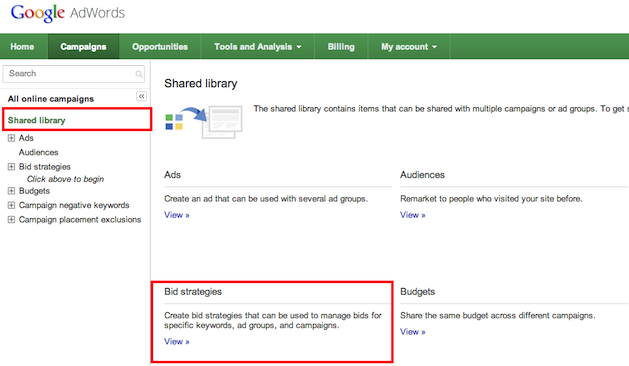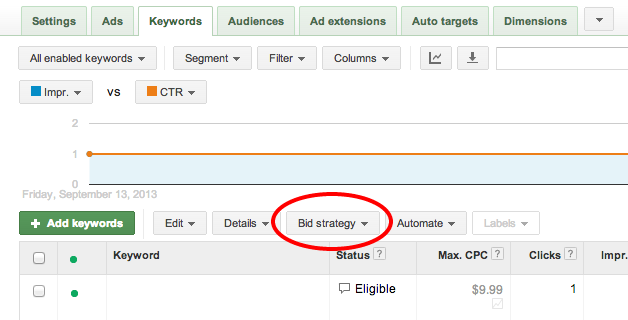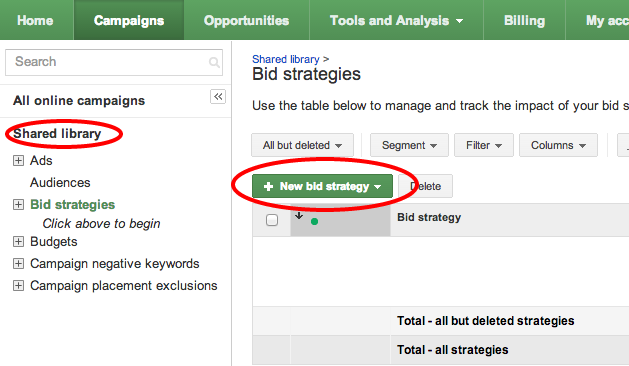So far, enhanced campaigns has brought with it a mixed bag of new features, modified features, and a few repackaged ones. Somewhere in the middle of all of those is Google’s set of changes to the way automatic bidding works. In the new Google Ads platform, there are four ways to approach your flexible bidding strategies, all but one of which had a previous incarnation in AdWords:
- Maximize Clicks (formerly automatic bidding)
- Target search page location (new!)
- Target cost-per-acquisition (CPA – think Conversion Optimizer)
- Enhanced cost-per-click (ECPC) – self-explanatory (it hasn’t really changed)
The only really new one of the bunch, Target search page location, is fairly straightforward: it prioritizes putting your ad at the top of the page or in the first page of search results. The rest all work the same as the old versions, but now can be reused across campaigns, ad groups, and keywords.
It can be easy to forget to make use of the built-in flexibility here. Don’t! In this post, I’ll go over the basics, cover the recent changes, and explain why they matter for your Google Ads campaigns.
What Are Flexible Bidding Strategies?
Put simply, they’re designed to give you a lot more control over automatic bidding for your ads. With flexible bidding strategies, you can customize how your bids work based on your performance goals, and apply that approach to any level of a campaign.

The main advantage to this feature is that you can adjust your bidding strategy based on what matters most to you. If you’re looking to get as much traffic to your site as possible, the Maximize Clicks strategy will position your bidding to optimize for clickthroughs. If ranking at the top of the page is your first priority, “Target search page location” will adjust your bids accordingly.
Unlike previous bidding options in Google Ads, flexible bidding strategies are accessed in the Google Ads Shared Library. Choose a strategy using the green “New Bid Strategy” button, and once you’ve created one, you can apply it at the campaign, ad group, or keyword level.

Why They Matter
Other than the aforementioned options, flexible bidding strategies are important because they are–for lack of a better word–flexible! Being able to choose different strategies for different campaigns, ad groups, and even keywords gives you a lot of control over how your ads are shown, all according to the goals you establish for them.
If you’re not already making use of this built-in flex, do it! It’s an easy and efficient way both to automate your bids and, with the ability to selectively choose which parts of a campaign the strategy applies to, retain control over the ones you’d rather handle manually.
Common Pitfalls
- Limiting your focus. Previously, bidding strategies only worked at the campaign level–they weren’t flexible (at least in the way Google is using the word). So, in the post-update Google Ads, it can be tempting to use them the way you did before, without taking advantage of the enhanced features. Don’t! Experiment with different strategies at the ad group or keyword level. You’ve got the power… use it!
- Misidentifying performance goals. As with any marketing campaign, it’s essential that you determine your strategy before choosing your tactics. When deciding how and where to apply different bidding strategies, think carefully about what your goals are for the campaign, ad group, or keyword you have in mind. Otherwise, you might find yourself wondering why your Google Ads results aren’t matching up with the potentials you know exist for your keywords and campaigns.
How To Use Them Better
- Get granular. Or, if you prefer the Apple flavor: think granular. True, campaigns can become hard to manage if you insist on customizing every last detail. Google Ads gives you a lot of flexibility, and if you get too caught up adjusting settings for each one of your keywords, it can easily become overwhelming.
- Still, that’s no reason not to get specific when the job calls for it. Similar ad groups and keywords may perform differently, and that means one approach isn’t going to work best for all of them. Keep an eye on the big picture, but don’t be afraid of getting micro and picking custom strategies for the parts of a campaign that could stand to use them.
- Use your analytics! The best way to figure out which parts of a campaign ought be matched with a particular strategy is to examine their performance in driving traffic, conversions, and your other key metrics. Use that information and apply it to your bidding strategies: if an ad group is driving a lot of traffic but not converting, try out the Target CPA strategy. If it’s the opposite, try changing it to Maximize Clicks.
- Big-picture strategy first. Experimenting is important, but rather than going in without a predetermined plan, you should be using the information available to you to craft a big-picture strategy that best matches bidding strategies to individual parts of your campaign. Go in with a coherent plan, and you’ll be better positioned to respond to your results and make changes as needed.
TL;DR – Try out different strategies across multiple levels of the campaign. Experiment with bidding strategies at the ad group and keyword level. Use the data you’ve got available to determine the best fit, and develop a broad strategy accordingly.


